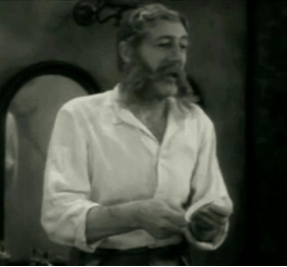Hypnotism and Its Past
[In earlier posts that you’ll find here and here, I’ve written about my fascination with hypnotism and my interviews and encounters with hypnotists of various types. In this post, I continue the series by scratching the surface of hypnotism’s history and looking at its popular portrayal.]

For centuries, hypnotism has suffered from an image problem. The pleasant experience of surrenduring to the thrall of a book, movie, or religious experience — all similar states of consciousness — is nothing like the popular conception of hypnotism, as promulgated by novels and other forms of entertainment.
In George DuMaurier’s Trilby, a much-filmed nineteenth-century novel about a man’s control over a concert singer, the hypnotist Svengali makes a spectacular first appearance. He was
a tall bony individual of any age between thirty and forty-five, of Jewish aspect, well featured but sinister. He was very shabby and dirty, and wore a red beret and a large velveteen cloak, with a big metal clasp at the collar. His thick, heavy, languid, lusterless black hair fell down behind his ears to his shoulders, in that musician-like way that is so offensive to the normal Englishman. He had bold, brilliant black eyes, with long heavy lids, a thin, sallow face, and a beard of burnt-up black, which grew almost from his under eyelids; and over it his moustache, a shade lighter, fell in two long spiral twists. He went by the name of Svengali, and spoke fluent French with a German accent and humorous German twists and idioms, and his voice was very thin and mean and harsh, and often broke into a disagreeable falsetto.
Like Svengali’s technique, the hypnotic induction methods of many fictional characters are exercises in power, unpleasant for the hypnotized person. They demonstrate the irresistible domination of the hypnotist.
Domination was not a motivation of the early hypnotists, including mothers of millennia past who sang and rocked their crying babies back and forth to comfort them. In the eighteenth century, Anton Mesmer, a Viennese physician, moved magnets over the bodies of prone patients. Mesmer postulated that a fluid called animal magnetism regulates human health, and that his magnets beneficially manipulated this life-giving energy. Mesmer’s treatment frequently brought patients to fits of high-pitched emotion, followed by a faint. Later, Armand-Marie-Jacques de Chastenet, one of Mesmer’s students, discovered that he could guide the thoughts and actions of his patients through mere suggestion, without magnets, and he sometimes made patients dance jerkily in their chairs.
The English surgeon James Braid, who coined the word “neurohypnotism,” meaning nervous sleep, typically treated patients by holding a lit candle before and above their line of sight. He would then suddenly thrust his other hand from the candle to patient’s eyes, producing a trance. Braid frequently made patients’ limbs rise and stiffen by passing a key over them. He was the first to hypothesize that hypnotic responses arise from mental suggestions that produce physical responses.
Sigmund Freud was a failure as a hypnotist, but not so other serious investigators of the twentieth century. Milton Erickson, M.D., an American who melded hypnotherapy with psychotherapy, freed his patients to follow their own inclinations while in hypnosis, and Morey Bernstein, an amateur hypnotist, worked closely with Virginia Tighe in Pubelo, Colorado, to carry her back to a supposed past life as an Irishwoman named Bridey Murphy. (Above is a hypnotism scene from the 1956 film The Search for Bridey Murphy.)
In 1976, hypnotist William Kroger helped Ed Ray, a part-time school bus driver in Chowchilla, California, remember the license plate number of the vehicle used by kidnapers who commandeered his bus full of schoolchildren and hid them in a moving van buried in a rock quarry. The captors’ arrest soon followed.
Therapeutic hypnotism has come a long way in recent decades, but its popular image unfortunately remains mired in the past.